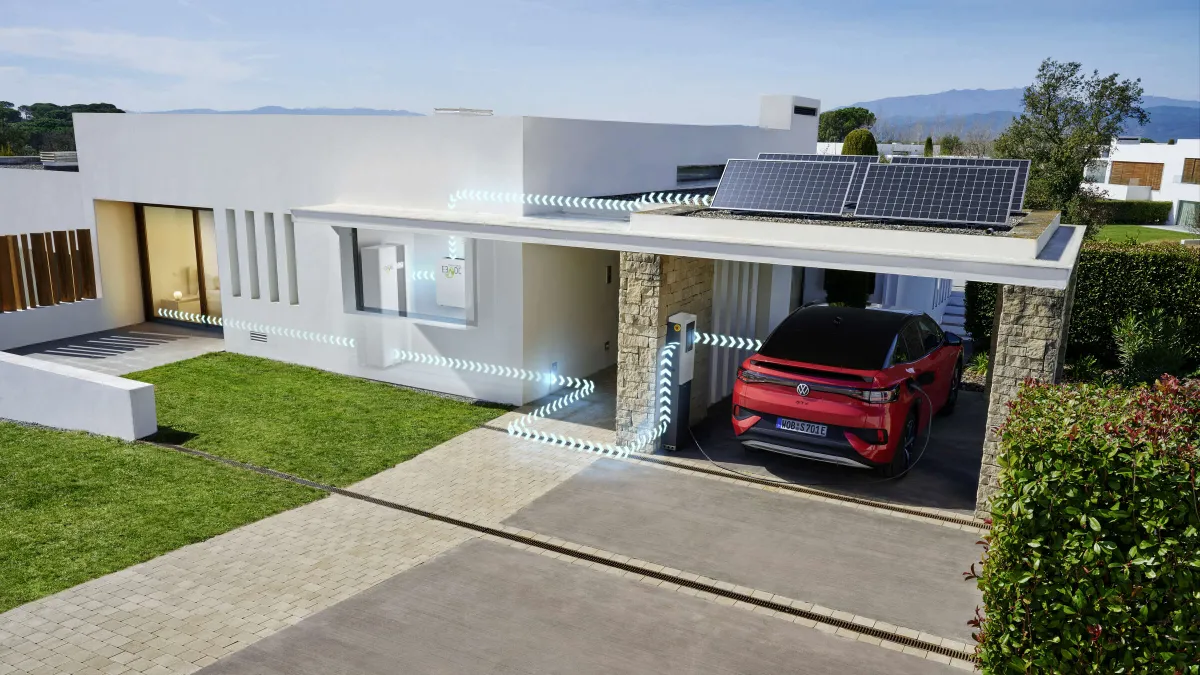Dive Brief:
- Volkswagen is launching a bidirectional, vehicle-to-home pilot program with HagerEnergy GmbH in Sweden, according to a press release.
- EV customers will be able to use the stored energy of the vehicle’s battery, in conjunction with a stationary energy system, to provide supplemental power to a home during peak times or in the event of a power failure.
- Volkswagen said it is now one of the first providers to provide a bidirectional charging solution based on the Combined Charging System standard used by EVs in Europe.
Dive Insight:
The bidirectional charging capabilities are available on all new Volkswagen ID electric models equipped with the larger 77 kilowatt hour battery and software version 3.5 or higher. Based on a home’s average energy consumption of 30 kWh per day, the 77 kWh battery can supply backup power for around two full days in the event of a power outage, according to the automaker.
In addition, a home with solar panels can be supplied with power on cloudy days or in the evening. Customers can also decide when to draw energy from the grid or use the electricity stored in their vehicle’s battery. Used in combination with HagerEnergy’s home energy storage system, the company says customers can cover as much of their household consumption as normally supplied by a solar photovoltaic system.
The vehicle’s battery can be used as the main source of power for a home whenever the storage system requires additional energy, Volkswagen said. As soon as the home’s storage system is sufficiently recharged, power is automatically disconnected from the vehicle and it goes into “standby” mode. However, the ID vehicle’s battery will not be discharged below 20% when connected to a home to ensure it's ready to be driven if needed.
"We are actively shaping the energy transition with products and services centered around the electric car: With the bidirectional charging function that is now available, we have tailored a new service offering to the needs of our customers,” said Imelda Labbé, Volkswagen board member for sales, marketing and after sales, in a press release.
Bidirectional charging technology is also being developed by other automakers, including Ford and General Motors. It allows homeowners to tap into the massive power reserves of EV batteries when the vehicle is stationary. Today’s EVs equipped with larger batteries can provide even more power than Tesla’s Powerwall, which delivers 13.5 kWh of usable energy.
This summer, GM said it will offer bidirectional charging capability for its Ultium-based electric vehicles by 2026. It will be available to residential customers through the automaker’s subsidiary GM Energy. The automaker’s Ultium Home V2H Enablement Kit includes a power inverter, home hub and dark start battery delivering 9.6 kW of discharge power as needed.
Ford also offers a bidirectional charging kit for the Ford F-150 Lightning. Customers first need to purchase an 80-amp Ford Charge Station Pro home charger, which connects to the automaker’s Home Integration System to enable bidirectional charging. The F-150 Lightning equipped with an extended-range battery can power a home for up to three days, according to Ford.
Volkswagen said it will be able to activate the vehicle-to-home function for ID vehicles already delivered as soon as these vehicles receive the new over-the-air 3.5 software update. Initially, the vehicle-to-home charging system can only be used with the S10 E Compact home power station from HagerEnergy GmbH. In the future, customers will be able to use a smaller bidirectional charging wallbox.












